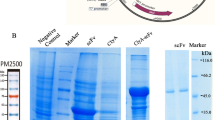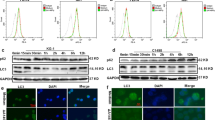Abstract
To identify more therapeutic targets and clarify the detailed mechanisms of Pseudomonas aeruginosa-mannose-sensitive hemagglutinin (PA-MSHA) on breast cancer cells both in vitro and in vivo. PA-MSHA was administered to epidermal growth factor receptor (EGFR)-positive human breast cancer cell lines MDA-MB-231HM and MDA-MB-468 in vitro and to mice bearing tumor xenografts. The mannose cocultured test was used to detect the effect of mannose on PA-MSHA-induced cell proliferation, cell cycle arrest, apoptosis, and EGFR pathway signaling. We found that cells stimulated with PA-MSHA exhibited a downregulation of EGFR signaling. The addition of mannose partially inhibited the PA-MSHA-stimulated cell anti-proliferative effect, cell apoptosis, cell cycle arrest, activation of apoptosis-associated caspases, and even downregulation of the EGFR signaling pathway. In vivo, PA-MSHA treatment significantly suppressed mammary tumorigenesis in xenografts in mice and decreased lung metastasis in MDA-MB-231HM cell-transplanted mice. Tumor sample analyses confirmed inhibition of the EGFR pathway in the PA-MSHA-treated mice. In conclusion, this study showed that the involvement of the mannose-mediated EGFR pathway has a critical function in the preclinical rationale for the development of PA-MSHA for the treatment of human breast cancer. It also suggests the potentially beneficial use of PA-MSHA in adjuvant therapy for breast tumors with EGFR overexpression.
This is a preview of subscription content, access via your institution
Access options
Subscribe to this journal
Receive 50 print issues and online access
$259.00 per year
only $5.18 per issue
Buy this article
- Purchase on Springer Link
- Instant access to full article PDF
Prices may be subject to local taxes which are calculated during checkout













Similar content being viewed by others
References
Capdevila J, Elez E, Macarulla T, Ramos FJ, Ruiz-Echarri M, Tabernero J . (2009). Anti-epidermal growth factor receptor monoclonal antibodies in cancer treatment. Cancer Treat Rev 35: 354–363.
Duguid JP . (1968). The function of bacterial fimbriae. Arch Immunol Ther Exp (Warsz) 16: 173–188.
Duncan MJ, Mann EL, Cohen MS, Ofek I, Sharon N, Abraham SN . (2005). The distinct binding specificities exhibited by enterobacterial type 1 fimbriae are determined by their fimbrial shafts. J Biol Chem 280: 37707–37716.
Eshdat Y, Sharon N . (1984). Recognitory bacterial surface lectins which mediate its mannose-specific adherence to eukaryotic cells. Biol Cell 51: 259–266.
Gibson S, Tu S, Oyer R, Anderson SM, Johnson GL . (1999). Epidermal growth factor protects epithelial cells against Fas-induced apoptosis requirement for Akt activation. J Biol Chem 274: 17612–17618.
Harper M, Turvey A, Bramley AJ . (1978). Adhesion of fimbriate Escherichia coli to bovine mammary-gland epithelial cells in vitro. J Med Microbiol 11: 117–123.
Helenius A, Aebi M . (2001). Intracellular functions of N-linked glycans. Science 291: 2364–2369.
Hoadley KA, Weigman VJ, Fan C, Sawyer LR, He X, Troester MA et al. (2007). EGFR associated expression profiles vary with breast tumor subtype. BMC Genomics 8: 258.
Jain RK, Forbes NS . (2001). Can engineered bacteria help control cancer? Proc Natl Acad Sci USA 98: 14748–14750.
Johns TG, Mellman I, Cartwright GA, Ritter G, Old LJ, Burgess AW et al. (2005). The antitumor monoclonal antibody 806 recognizes a high-mannose form of the EGF receptor that reaches the cell surface when cells over-express the receptor. FASEB J 19: 780–782.
Kang CS, Zhang ZY, Jia ZF, Wang GX, Qiu MZ, Zhou HX et al. (2006). Suppression of EGFR expression by antisense or small interference RNA inhibits U251 glioma cell growth in vitro and in vivo. Cancer Gene Ther 13: 530–538.
Karlsson KA . (2001). Pathogen-host protein-carbohydrate interactions as the basis of important infections. Adv Exp Med Biol 491: 431–443.
Kawashima N, Yoon SJ, Itoh K, Nakayama K . (2009). Tyrosine kinase activity of epidermal growth factor receptor is regulated by GM3 binding through carbohydrate to carbohydrate interactions. J Biol Chem 284: 6147–6155.
King SS, Young DA, Nequin LG, Carnevale EM . (2000). Use of specific sugars to inhibit bacterial adherence to equine endometrium in vitro. Am J Vet Res 61: 446–449.
Klumpp DJ, Rycyk MT, Chen MC, Thumbikat P, Sengupta S, Schaeffer AJ . (2006). Uropathogenic Escherichia coli induces extrinsic and intrinsic cascades to initiate urothelial apoptosis. Infect Immun 74: 5106–5113.
Korhonen TK, Leffler H, Svanborg Eden C . (1981). Binding specificity of piliated strains of Escherichia coli and Salmonella typhimurium to epithelial cells, saccharomyces cerevisiae cells, and erythrocytes. Infect Immun 32: 796–804.
Korhonen TK, Lounatmaa K, Ranta H, Kuusi N . (1980). Characterization of type 1 pili of Salmonella typhimurium LT2. J Bacteriol 144: 800–805.
Lage A, Crombet T, Gonzalez G . (2003). Targeting epidermal growth factor receptor signaling: early results and future trends in oncology. Ann Med 35: 327–336.
Liu B, Cheng Y, Bian HJ, Bao JK . (2009a). Molecular mechanisms of Polygonatum cyrtonema lectin-induced apoptosis and autophagy in cancer cells. Autophagy 5: 253–255.
Liu B, Min MW, Bao JK . (2009b). Induction of apoptosis by Concanavalin A and its molecular mechanisms in cancer cells. Autophagy 5: 432–433.
Liu ZB, Hou YF, Di GH, Wu J, Shen ZZ, Shao ZM . (2009c). PA-MSHA inhibits proliferation and induces apoptosis through the up-regulation and activation of caspases in the human breast cancer cell lines. J Cell Biochem 108: 195–206.
McEwan NA, Reme CA, Gatto H, Nuttall TJ . (2008). Monosaccharide inhibition of adherence by Pseudomonas aeruginosa to canine corneocytes. Vet Dermatol 19: 221–225.
Mulvey MA, Lopez-Boado YS, Wilson CL, Roth R, Parks WC, Heuser J et al. (1998). Induction and evasion of host defenses by type 1-piliated uropathogenic Escherichia coli. Science 282: 1494–1497.
Ofek I, Beachey EH . (1978). Mannose binding and epithelial cell adherence of Escherichia coli. Infect Immun 22: 247–254.
Schaerli P, Jaggi R . (1998). EGF-induced programmed cell death of human mammary carcinoma MDA-MB-468 cells is preceded by activation AP-1. Cell Mol Life Sci 54: 129–138.
Schilling JD, Mulvey MA, Hultgren SJ . (2001). Structure and function of Escherichia coli type 1 pili: new insight into the pathogenesis of urinary tract infections. J Infect Dis 183 (Suppl 1): S36–S40.
Sharon N . (1987). Bacterial lectins, cell-cell recognition and infectious disease. FEBS Lett 217: 145–157.
Sharon N . (2006). Carbohydrates as future anti-adhesion drugs for infectious diseases. Biochim Biophys Acta 1760: 527–537.
Stepinska M, Trafny EA . (1995). Modulation of Pseudomonas aeruginosa adherence to collagen type I and type II by carbohydrates. FEMS Immunol Med Microbiol 12: 187–194.
Wang JS, Wang FB, Zhang QG, Shen ZZ, Shao ZM . (2008). Enhanced expression of Rab27A gene by breast cancer cells promoting invasiveness and the metastasis potential by secretion of insulin-like growth factor-II. Mol Cancer Res 6: 372–382.
Wiest I, Seliger C, Walzel H, Friese K, Jeschke U . (2003). Int Inst Anticancer Research: Hamburg, Germany. pp 1575–1580.
Zhang H, Berezov A, Wang Q, Zhang G, Drebin J, Murali R et al. (2007). ErbB receptors: from oncogenes to targeted cancer therapies. J Clin Invest 117: 2051–2058.
Acknowledgements
We are grateful to Professor Xi-Liang Zha for providing technical assistance. This work was supported in part by the Key Discipline Innovation Personnel Training Program of Fudan University (Contract grant number: EHF159201), National Basic Research Program of China (Contract grant number: 2006CB910501), the National Natural Science Foundation of China (Contract grant numbers: 30371580 and 30572109), and the Shanghai Science and Technology Committee (Contract grant numbers: 06DJ14004, 06DZ19504, and 08ZR1403500).
Author information
Authors and Affiliations
Corresponding author
Ethics declarations
Competing interests
The authors declare no conflict of interest.
Additional information
Supplementary Information accompanies the paper on the Oncogene website
Supplementary information
Rights and permissions
About this article
Cite this article
Liu, ZB., Hou, YF., Zhu, J. et al. Inhibition of EGFR pathway signaling and the metastatic potential of breast cancer cells by PA-MSHA mediated by type 1 fimbriae via a mannose-dependent manner. Oncogene 29, 2996–3009 (2010). https://doi.org/10.1038/onc.2010.70
Received:
Revised:
Accepted:
Published:
Issue Date:
DOI: https://doi.org/10.1038/onc.2010.70
Keywords
This article is cited by
-
Systems-level analyses of protein-protein interaction network dysfunctions via epichaperomics identify cancer-specific mechanisms of stress adaptation
Nature Communications (2023)
-
PA-MSHA induces inflamed tumor microenvironment and sensitizes tumor to anti-PD-1 therapy
Cell Death & Disease (2022)
-
Intravesical Pseudomonas aeruginosa mannose-sensitive Hemagglutinin vaccine triggers a tumor-preventing immune environment in an orthotopic mouse bladder cancer model
Cancer Immunology, Immunotherapy (2022)
-
PA-MSHA induces apoptosis and suppresses metastasis by tumor associated macrophages in bladder cancer cells
Cancer Cell International (2017)
-
Both HDAC5 and HDAC6 are required for the proliferation and metastasis of melanoma cells
Journal of Translational Medicine (2016)



